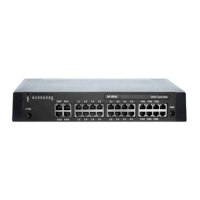30
A
PPLICATIONS AND APPLICATION INTERFACES
CHAPTER 2 SYSTEM OVERVIEW
• Dialling by name for outgoing calls and CLIP display for incoming calls offers an added value by the
integration of external directories and databases.
• Notification of Microsoft Outlook appointments on the system phones
• Presence-controlled communications with Busy Indicator
• Automatic Call Distribution
• Access to system configuration, what a maximum integration of different systems ensures
And of course the communication system supports also First and Third-Party CTI interfaces for commer-
cial CTI applications based on the Microsoft TAPI 2.1 standard.
Terminal supervision/control on the communication server by third-party applications via the CSTA
protocol is also supported.
First-party CTI
A first-party CTI is the direct physical connection between a phone terminal and a telephony Client (work-
station PC). Telephony functions and telephone states are controlled and monitored on the telephony
Client. A first-party CTI solution is ideal for a small number of CTI workstations and is easily implemented.
MiVoice Office 400 supports First-Party CTI on all system phones via the Ethernet interface. For some
applications (e.g. Office eDial) the First-Party TAPI Service Provider (AIF-TSP) is required. Other appli-
cations (e.g. Mitel Dialer) use the CSTA protocol.
Application example
• Dialling from a database (phone book CD, etc.)
• Caller identification (CLIP)
• Creating a call journal
• Mitel Dialer Mitel applications
Third-party CTI
Third-party CTI is an user-friendly multi-station solution. In contrast to first-party CTI, third-party CTI
controls and monitors several system phones (including cordless phones) via the central telephony
server, which is connected with the communication server. In addition phones on ISDN and analogue
interfaces can also be monitored. PC and phone allocation is handled by the telephony server.
The third-party CTI connection is effected via Ethernet using the Mitel Open Interfaces Platform (OIP). To
this end the OIP is installed on the telephony server. Third-party connections via Ethernet with CSTA are
also possible.
Application example
• Busy indicator
• Group functionality
• Networked CTI solution
• Automatic Call Distribution (ACD)
ISDN interface
MiVoice Office 400 supports the ISDN protocols ETSI, DSS1 and QSIG.
1
Besides the possibility of
networking various systems into a PISN (Private Integrated Services Network) via the ISDN interface,

